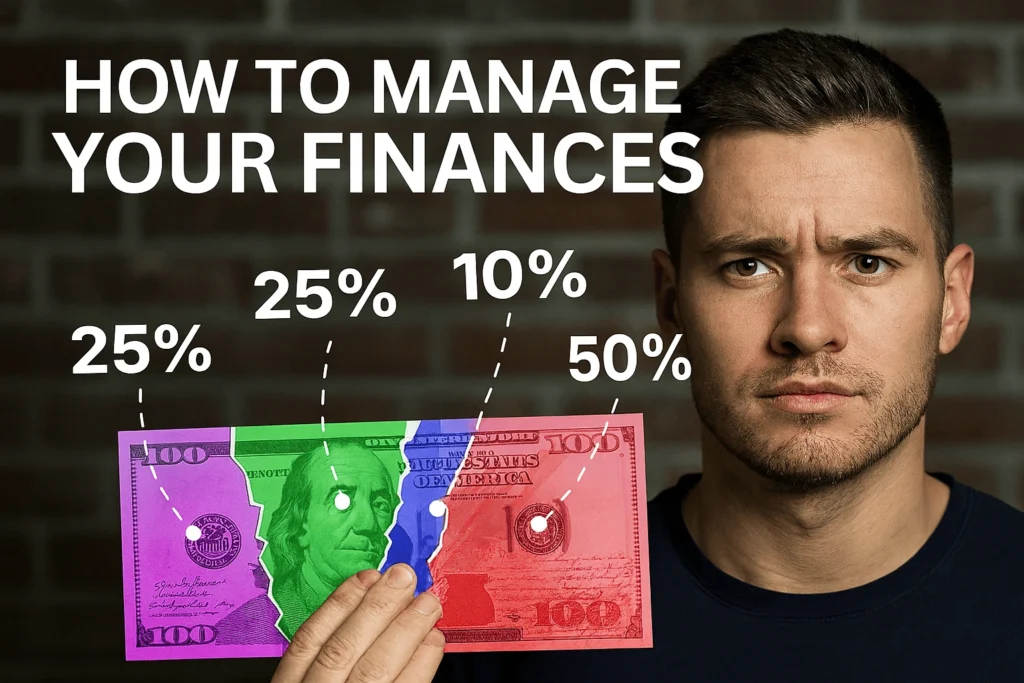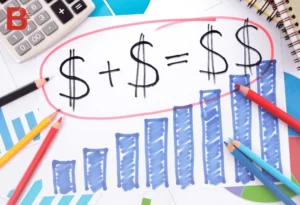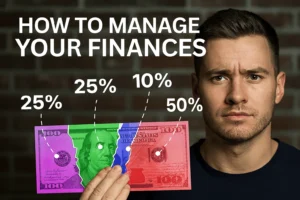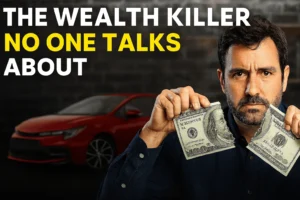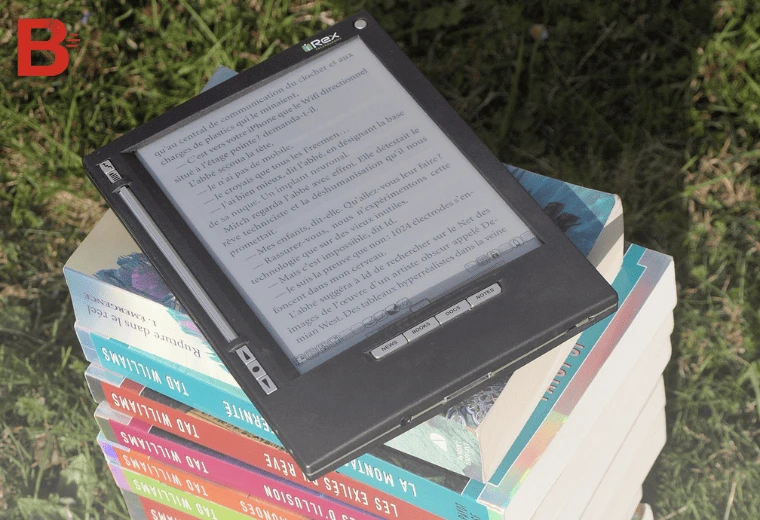Introduction: What the Rich Know That You Don’t
How to manage your finances Let me tell you something that could change your life—if you let it sink in.
According to wealth studies, the richest people in the world fall into these categories:
- 75% are Entrepreneurs
- 15% are Investors
- 7% inherited wealth
- 3% are Athletes, Artists or Celebrities
- 0% became wealthy from just a salary
Read that again. 0%.
So what do they all have in common?
They own something.
- Entrepreneurs own businesses
- Investors own assets
- Rich kids own trusts
- Celebrities own unique skills
If you don’t own something, you are what’s owned.
That’s the secret most people miss. And that’s exactly why I created the 25-15-50-10 Rule—a proven method to manage your money like the top 1%, no matter your income.
What Is the 25-15-50-10 Rule?
How to manage your finances
This rule is a wealth-building budget framework:
- 25% Growth — Money that works for you
- 15% Stability — Your financial safety net
- 50% Essentials — What keeps you functioning
- 10% Rewards — For enjoying life (guilt-free!)
This isn’t theory. I used this method myself—starting from nothing—to become a multimillionaire without fancy degrees or a trust fund.
Let’s break it down step by step.
25% Growth: Money That Works While You Sleep
This is your freedom fund. It’s not about spending—it’s about building wealth that works for you.
What Counts as “Growth”?
Growth means buying assets that go up in value or generate income.
Not “feel-good” spending like self-help courses or inspirational posters.
We’re talking:
- Index funds (e.g., S&P 500)
- Real estate (rental or REITs)
- Dividend-paying stocks
- High-income skills (e.g., sales, coding, copywriting)
- Profitable online businesses
- Crypto and alternative assets (for advanced users)
“If you don’t find a way to make money while you sleep, you’ll work until you die.” — Warren Buffett
Mind-Blowing Example: Billy vs. Phil
- Billy invests $200/month starting at age 20
- Phil invests $300/month starting at 30
By 60, assuming 10% returns (S&P 500 average):
- Billy = $1,264,816
- Phil = $678,146
Billy ends up with $600K more even though he invested less money, just because he started earlier.
That’s compound growth in action.
How to Start Investing the Smart Way
Step 1: Choose Growth Assets
- Beginner: Index funds (e.g., VOO, SPY, IWDA)
- Moderate: REITs, dividend stocks, side hustles
- Advanced: Crypto, small-cap stocks, online business
Step 2: Use Tax-Advantaged Accounts
- 🇺🇸 US: Roth IRA, 401(k)
- 🇬🇧 UK: Stocks & Shares ISA, Pension
- 🇨🇦 Canada: TFSA
- Others: Research your country’s retirement/investment accounts
Step 3: Automate & Forget
- Set up auto-investing on payday
- Use apps like Vanguard, Trading 212, SoFi, M1 Finance
- Build a simple 3-fund portfolio:
- U.S. Stock Index Fund
- Global Stock Fund
- Bond Fund
Affiliate Tip: Recommend platforms like Trading 212 or M1 Finance with referral codes.
15% Stability: Protect What You’ve Built
How to manage your finances
This part keeps you in the game.
It’s your emergency fund, your buffer, your lifeline when things go wrong.
“Most people don’t have a money problem—they have a stability problem.”
Step-by-Step: Building Financial Stability
Step 1: Calculate Your Baseline Expenses
Add up:
- Rent/mortgage
- Utilities
- Food
- Transportation
- Insurance
That’s your monthly survival number. Multiply it by 5.
Example: $1,500/month × 5 = $7,500 emergency fund goal
Step 2: Store It Safely
Rules:
- Easy Access — Must be available in 24 hours
- Zero Risk — No stock market, no crypto
- Earns Interest — Use a high-yield savings account (4–5%)
Best options:
- Ally Bank
- SoFi
- Marcus by Goldman Sachs
Step 3: Automate Saving
- Paycheck Sweep — 15% of your income, direct transfer on payday
- Round-Up Apps — Save spare change from purchases
- Cashback to Savings — Use cashback rewards to boost your emergency fund
50% Essentials: Covering Your Needs, Not Your Ego
How to manage your finances
This is where most people blow their money.
But guess what? Wealthy people live below their means—even when they don’t have to.
“You can be broke on $100K/year if you spend like a fool.”
What Counts as “Essential”?
Needs, not wants:
- Rent or mortgage
- Groceries
- Insurance
- Utility bills
- Basic transportation
- Basic clothing
What’s Not Essential?
- Uber Eats every night
- Netflix, Disney+, and Hulu (all at once?)
- Gym you don’t use
- Subscriptions you forgot exist
- Designer clothes
Cut the 2 Big Killers: Housing & Transport
Housing
- Negotiate rent
- Downsize if needed
- House-hack (roommates, AirBnB, move home temporarily)
Transport
- Avoid car leases
- Buy used and reliable (Toyota, Honda)
- Use public transport or car-sharing if possible
Use Rules, Not Willpower
Create spending filters:
- Is this an impulse purchase?
- Use the 7-Day Rule
- Am I buying for the brand or value?
- Will this improve my life long-term?
10% Rewards: Enjoy Without Guilt
How to manage your finances
This is what keeps your money plan sustainable.
“All grind and no joy makes you burn out fast.”
What to Spend It On?
- Vacations (you’re buying memories, not stuff)
- Hobbies (keeps you sane and motivated)
- Gifts (relationships matter)
- Dinners, experiences, social life
The Joy Jar System
- Open a separate account (same bank or app)
- Call it “Joy Jar”
- Automatically send 10% of income monthly
Rule: If you run out, wait until next month—no stealing from growth or stability.
Why This System Works (Psychology + Math)
Most people fail with money not because they don’t earn enough, but because they don’t have a system.
This rule:
- Ensures discipline without deprivation
- Builds long-term security + short-term joy
- Creates momentum toward financial independence
Whether you make $2,000 or $20,000/month, the system scales with you.
Resources to Take It Further
How to manage your finances
Books:
- The Psychology of Money — Morgan Housel
- Rich Dad Poor Dad — Robert Kiyosaki
- I Will Teach You To Be Rich — Ramit Sethi
- Your Money or Your Life — Vicki Robin
Platforms (for affiliate links):
- Vanguard
- M1 Finance
- Trading 212
- SoFi
- Ally Bank
FAQ: The 25-15-50-10 Rule Explained
1. Can I use this rule if I’m on minimum wage?
Yes. Even saving small percentages consistently creates powerful habits and compound growth.
2. Should I pay off debt before investing?
Build a $1,000 emergency fund first, then prioritize high-interest debt (e.g., credit cards) before investing.
3. What’s the best growth asset for beginners?
An S&P 500 index fund (like VOO or VTSAX) is simple, diversified, and effective.
4. What if my essentials are more than 50% of my income?
Temporarily adjust, but work on cutting expenses and increasing income to hit the 50% goal.
5. Is the 25-15-50-10 rule better than 50-30-20?
Yes. It’s more strategic and aligned with building wealth—not just budgeting for survival.
6. Can I include skills under “growth”?
Absolutely. Learning high-income skills is one of the fastest ROI moves you can make.
7. Is crypto a growth asset?
Only for advanced users. Keep it to 5–10% of your growth portfolio.
8. What’s a good emergency fund size?
Aim for 3–6 months of core expenses. 5 months is the sweet spot.
9. Should I use a separate bank for each category?
Not necessary, but having separate sub-accounts or apps helps keep things organized.
10. What happens when I get a raise?
Stick to the percentages, and you’ll automatically invest and save more.
11. Is the 10% reward fund really necessary?
Yes! It helps prevent burnout and creates a positive relationship with money.
12. How do I invest globally?
Use international index funds like IWDA or VT to diversify beyond your country.
13. How do I avoid lifestyle inflation?
Lock your lifestyle at 50% and put raises into growth or stability instead of spending.
14. Should I rent or buy a home?
Depends. Renting gives flexibility. Owning builds equity. Do what aligns with your goals + stability.
15. How do I find my actual monthly baseline?
Track your expenses for 30 days using tools like Mint, YNAB, or Excel.
16. Are skills really better than stocks?
Yes—for fast cash flow and income growth. You can later invest the profits.
17. What if I have irregular income?
Base the percentages on your lowest average month to stay safe.
18. What’s the best app for investing?
Depends on your country. For the U.S., M1 Finance and Fidelity. For the UK, Trading 212.
19. How do I teach this to my kids?
Open a custodial Roth IRA, start a savings match program, and explain the 4 categories with allowance.
20. What if I’ve already made financial mistakes?
Start now. You don’t need to be perfect—just consistent and intentional.
Final Thoughts: Own Your Future
You don’t need to be rich to use this rule. But if you use it long enough, you might just become rich.
“If you don’t own something—you are something that’s owned.”
Start today.
Stay consistent.
And let your money finally work for you.
Looking for one of these top-selling gadgets?
Support the blog and level up your tech by buying through our Amazon partner store — you pay the same price, AND you’re helping us create more content like this! Just click the link, choose your product:
Smartphones:
Notebooks:
Smartwatches:
Audio & Streaming:
Thanks so much for your support! 🙌

